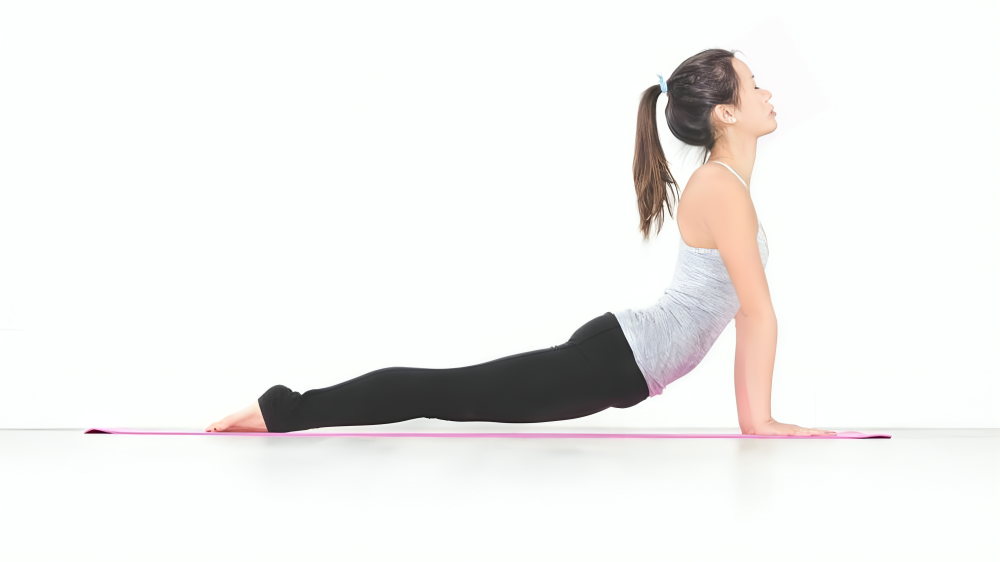
What Is Urdhva Mukha Svanasana (Upward Facing Dog)
Urdhva= “upward”
Mukha= “face”
Svanasana= “dog posture”
Together, it is Upward-Facing Dog Pose—such a refreshing backbend that opens your chest, strengthens your arms, and stretches your abdominals.
How to Practice Urdhva Mukha Svanasana
Prone Positioning – Lie flat on your stomach, legs extended backward, tops of the feet pressing softly on the floor.
Place your palms on the ground at the bottom of your shoulders. Extend your fingers, and share the weight of your body equally on the palms.
Press into your hands and lift your chest – On inhale, press down into the ground with your hands, spread your arms out wide to stretch fully and lift your chest off the floor. Your thighs and shins should be lifted off the ground, but only the tops of your feet touch the ground.
Engage the legs: Provide support to the lower back and spine by engaging the muscles of the legs. Imagine pushing the top of your thighs against the ceiling.
Chest open forward: Roll your shoulders back, away from your ears, to open up your chest. Keep your neck long, looking a little bit up without straining your neck.
Hold and breathe – Stay in this position for 5 to 10 breaths, feeling the opening on your spine, chest, and arms.
Gently release – Return your body to the floor as you exhale from the pose. Come out of the pose into Child’s Pose or downward-facing dog.
The benefits of Urdhva Mukha Svanasana
Strengthens the Arms and Wrists
You actually work the muscles throughout your arms, wrists, and shoulders by pushing down on your hands and straightening your arms. The more you practice, the more strength and stabilization develop in these areas, which could even help improve your overall posture.
Opens the Chest and Shoulders
Upward Facing Dog is a great heart opener. The chest just kind of opens up, and through this opening, you can really get deeper breaths to improve your lung capacity. This opening can really help you get rid of tension in your shoulders if you spend most of your day sitting in a chair at the office.
Flexibility in the Spine Increases
This is a gentle yet effective backbend, encouraging flexibility in the spine. Regular practice may even help cure stiffness and discomfort in the back, which makes it especially useful for sedentary lifestyles or people with poor posture.
Abdomen and Hip Flexor Stretching
It stretches front side of the body entirely, from abdomen to thigh flexor; ideal to be done against tightness arising in most people who sit for long hours.
Boosts Energy Levels
Urdhva Mukha Svanasana can really give you that energized and revitalizing boost, opening up your chest to allow proper flow of blood. Try this one when you need a morning wake-up or a midday pick-me-up.
Eases Fatigue and Stress
Much like many yoga poses, Upward Facing Dog tends to be calming for the mind. So, the practice through your breath and body stretch can get rid of worries and tension, so you feel more centered and relaxed.
Improves Posture
This postures helps to strengthen the muscles along the back and open the chest which counteracts the slouching and rounded shoulders so common with sitting. Over time it contributes to better posture and a well-aligned spine.
It’s Here Mayurasana How to Do It and what are the Benefits
FAQs
**Q: Can I practice Urdhva Mukha Svanasana daily?
A: Of course! You can practice this every day, especially as one of your morning yoga poses. Just remember to listen to your body and not to overdo it.
Q: What is the difference between Urdhva Mukha Svanasana and Bhujangasana or Cobra Pose?
A: Well, in Urdhva Mukha Svanasana, your thighs and pelvis lift off the ground, but in Bhujangasana, or Cobra, they do not.
Q: How long should I hold the posture? \
A: Start with five breaths and gradually increase it up to 10 or more as you start gaining strength and flexibility in the posture.

